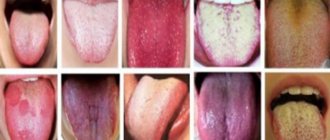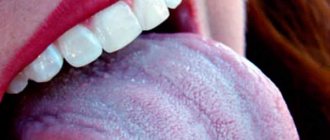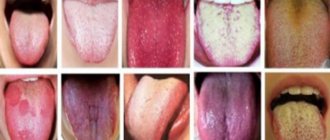The presence of yellow plaque spots in the oral cavity, namely on the tongue, is an obvious sign of impaired liver function and diseases of the gastrointestinal tract. The intensity of the staining of the spots indicates the stage of development of the disease; the darker the shade of the plaque and the thicker its layer, the more advanced the form of the disease we can talk about.
Plaque formations of insignificant area and density, not too intensely colored, can indicate infectious processes occurring in the body. In the summer heat, a slight yellowing of the tongue is completely normal.
Factors in the occurrence of plaque formations on the tongue
A yellow coating on the tongue indicates problems with the gastrointestinal tract.
There are a number of reasons that mainly influence the appearance of yellow plaque spots in the tongue area:
- Disturbances in the functioning of the gastrointestinal tract - there is a certain pattern here. If the tongue is evenly covered with a thin layer of loose plaque and is easily cleaned off the mucous membrane, this indicates a high level of slagging and concentration of toxic substances.
- When plaque stains of an intense yellow hue or yellowish-gray are observed, the oral cavity serves as a source of a repulsive odor, this should be very alarming. Doctors say that the denser the formations on the tongue and the more intense their coloring, the more dangerous pathological processes occur in the organs, in particular in combination with nausea this is a sign of all kinds of gastric dysfunctions. At the deepest stages of the disease, the plaque becomes yellow with a hint of brown, unpleasant taste sensations appear in the mouth, and the patient begins to suffer from bouts of nausea.
- Liver dysfunction and improper functioning of the pancreas are also a significant factor in the appearance of a yellow coating on the tongue. A bright yellow tongue or mixed with greenish tints, saliva with a bitter taste - these are the main complaints of these patients. These symptoms, combined with the presence of a taste of iron in the mouth, indicate a violation of bile secretion.
Yellow coating on the tongue: when not to worry
If a strange tint appears on your tongue, do not immediately sound the alarm. The color of the plaque may vary depending on the time of year. For example, in summer in hot weather with a lack of water, the plaque may have a yellowish tint, in winter it can be white-yellow. Do not forget about coloring foods (citruses, apricots, coffee, strong tea), bad habits and medications - they can also cause yellow plaque.
Such plaque can usually be quickly removed with a toothbrush or scraper. If it is impossible to get rid of it with the help of hygiene products, and in addition there is an unpleasant odor from your mouth, then it’s time to see a doctor.
Taking medications
A yellow coating on the tongue may appear from constant use of antibiotics.
Often people notice the appearance of a layer of yellow coating on the tongue after taking vitamin complexes.
This should not be alarming, since the coloring of the tongue occurs due to the pigment substances contained in such preparations.
The phenomenon is temporary. Long-term use of antibiotics can also cause yellow plaque spots.
The reason for this is that the liver is overloaded with various chemicals that need to be processed, as a result of which the organ works in too intense a mode, releasing a certain amount of toxic substances into the body.
It should be noted here that medications themselves are in no way a factor in the occurrence of plaque; when taken, they negatively affect the functioning of the digestive organs, and it is disturbances in the food processing processes that affect the coloration of the tongue yellow.
What does the color of sputum indicate when you cough?
Sputum that is rusty or brown in color
The rusty color of sputum when coughing, as well as its brown shades, is often found in smokers. This happens due to the accumulation of tobacco combustion products.
In other cases, a reddish-red hue of mucus is a sign of blood in the respiratory tract. However, there is no need to panic: this happens when small blood vessels rupture during a strong cough, and the darker the mucus, the more time has passed since the blood loss.
Brown and rust-colored sputum can be caused by:
- inflammation of the bronchi or lungs;
- blockage of blood vessels;
- pneumonia;
- cystic fibrosis;
- lung abscess.
Yellow sputum
Yellow bronchial mucus is common. This is a kind of response of our immune system to the appearance of infection in the respiratory tract.
The yellow tint of mucus is characteristic of:
- flu;
- ARVI;
- bronchitis;
- sinusitis.
If the sputum is yellow when coughing and contains impurities of pus, this may indicate pneumonia. The bright canary color is characteristic of pulmonary aspergillosis, a disease caused by the mold Aspergillus.
In many cases, yellow mucus appears in the initial stages of colds. As the pathological process progresses, it acquires a greenish tint.
Green sputum
Green mucus is a sign of an active bacterial infection. The causative agents can be staphylococci, streptococci, Klebsiella.
Diseases that occur with green sputum:
- sinusitis;
- sinusitis;
- purulent bronchitis;
- laryngitis;
- pneumonia;
- cystic fibrosis (sputum is produced in the form of lumps);
- lung abscess (thick green mucus with a distinct unpleasant odor).
Green sputum when coughing gets this color due to white blood cells - neutrophils. This is the most numerous group of leukocytes, and they are the ones “attracted” by the body to fight fungal and bacterial infections. Neutrophils simply absorb pathogenic microorganisms - so they always end up in the place where the pathogen appears.
Pink or red sputum
Pink sputum usually indicates mild bleeding, which is provoked by aggressive coughing attacks. However, if symptoms do not decrease for more than three days, or the sputum becomes more saturated red, you should immediately consult a doctor.
The mucus gets its red color due to the presence of blood impurities. This symptom is typical for:
- tuberculosis;
- abscess;
- pulmonary infarction;
- oncological diseases of the respiratory system;
- pulmonary edema.
In addition, foamy mucus with bloody inclusions is a characteristic sign of anthrax.
But foamy pink sputum when coughing often indicates pulmonary edema, which in turn can be caused by heart failure. The appearance of such mucus during expectoration is a reason to consult a cardiologist.
Bloody sputum often indicates a dangerous condition, so you should never hesitate to see a doctor.
White sputum
White sputum is a signal of an inflammatory process in the respiratory tract.
- It can often be observed in the initial stages of viral bronchitis (in later stages, the mucus becomes yellow or greenish).
- Another reason for the appearance of white sputum is being in an environmentally unsafe place and, as a result, intoxication of the body. It can also be caused by taking certain medications or drugs.
- If white mucus is released in the form of lumps and the consistency resembles curdled, this may be a sign of pneumonia of fungal origin. Antibiotics do not help in this situation: to treat this type of inflammation, special antifungal therapy is required.
White sputum when coughing means that the mucous membrane of the respiratory tract is swollen. Because of this, liquid transparent mucus cannot easily move through them, and gradually acquires viscosity and a white color.
Gray or blackish sputum
A light gray tint to sputum is natural for infectious diseases in their initial stages. It could be:
- acute respiratory infections;
- ARVI;
- flu.
Saturated gray or black mucus is quite rare. In particular, miners and representatives of other professions in which they have to inhale air with a large amount of suspended particles: coal dust, iron shavings, etc., suffer from a cough with the release of this kind of sputum.
Coloring substances in products such as Coca-Cola, strong tea, and dark chocolate can also give sputum a dark color.
Smoking can also cause gray and black mucus: this is typical for long-term smokers.
In some cases, the gray color of sputum when coughing indicates an advanced stage of tuberculosis, as well as cancer of the respiratory system.
Yellow tongue in children
Yellow spots on a child’s tongue indicate a gastrointestinal disease.
In children, disruption of the gastrointestinal tract may also be accompanied by yellow spots on the tongue.
Symptoms of the disease also include painful abdominal cramps, nausea, the child’s reluctance to eat, constipation or, conversely, diarrhea.
Eating excessive amounts of food and consuming fatty foods overloads the digestive system of children, so after several hours of overeating, the child begins to feel a dry mouth, feels nauseous, and the tongue becomes covered with a layer of yellow plaque.
- Just like in adults, infections accompanied by fever also affect the condition of the tongue.
- Sudden changes in body temperature, vomiting and stool disturbances are a source of plaque with a brownish tint due to drying out of the mucous membrane and cracking of the tongue, which is accompanied by microbleeding.
- In case of poisoning, the tongue becomes coated due to increased load on the liver. In such situations, plaque is affected by water deficiency in the body.
- In infantile jaundice, the tongue may also turn yellow. This also applies to such types of jaundice as yellowing of the integument due to hepatitis.
- Lesions of the mucous membrane due to inflammatory processes in the mouth, such as stomatitis, carious tooth decay, give rise to pigmentation of the tongue.
- Kidney failure, diabetes mellitus, and disorders of the immune system disrupt metabolism, thereby promoting the accumulation of waste and toxins, which causes the tongue to become yellow.
Causes of yellow sputum
Purulent bronchitis
The acute process is characterized by a frequent wet cough, which is accompanied by expectoration of dirty yellow sputum.
The bronchial discharge is liquid, with an unpleasant odor, and occasionally there are individual yellow-green lumps in it. Coughing increases in the morning after inhalation. Patients experience chest pain, shortness of breath, and increased body temperature. In chronic bronchitis, outside the period of exacerbation, a person occasionally expectors yellow sputum, but the cough mainly ends with the discharge of cloudy mucus. An increase in coughing attacks and an increase in the amount of yellow purulent discharge is observed with exacerbation of inflammation. The symptom is combined with signs of intoxication and decreased performance. With a long history of bronchitis, broncho-obstructive syndrome develops.
Lung abscess
The production of yellow, foul-smelling sputum is characteristic of the second period of the disease—breakthrough of the abscess into the draining bronchus. This happens suddenly: a dry cough gives way to a wet one, then a large volume of liquid purulent discharge is coughed up “with a mouthful.” Taking into account the size of the infected cavity, up to 0.5-1 liters of yellow sputum can be released per day after opening the abscess.
There is a clear connection between the onset of coughing up yellow pus and the general condition of the patient. In the first period, a person suffers from hectic fever, chills, severe chest pain and a painful non-productive cough. After the sputum is discharged, the state of health quickly improves, body temperature normalizes, and signs of intoxication disappear.
Bronchiectasis
The appearance of thick yellow sputum is typical for mild and moderate forms of the pathology, while in severe cases green discharge with a putrid odor is observed. Coughing up yellow pus occurs during an exacerbation of bronchiectasis (1-4 times a year). During the day, a person secretes up to 200 ml of yellow sputum, the main volume of which occurs in the morning - after waking up, pus is coughed up “with a mouth full”.
Throughout the day, coughing attacks occur as secretions accumulate in the bronchi. During paroxysms, a small amount of yellow sputum mixed with mucus is released. When the bronchial capillaries are injured due to a severe coughing attack, streaks of blood are noticeable in the purulent discharge. The patient is concerned about shortness of breath and symptoms of respiratory failure, intoxication, and exhaustion of the body.
Yellow sputum
Chronic obstructive pulmonary disease
The release of yellowish sputum when coughing indicates an exacerbation of the disease and the addition of a bacterial infection. Patients complain of increased cough paroxysms during the day, after which thick sputum is coughed up. Specific changes in the bronchopulmonary system and ventilation disorders contribute to the proliferation of microorganisms, therefore purulent processes in COPD are observed several times a year.
Pulmonary eosinophilia
The pathognomonic symptom of this group of pathologies is the appearance of bright yellow (canary) sputum, which is caused by an increased content of eosinophils in the mucus. The symptom occurs in diseases of various etiologies: parasitic pulmonary infestations (ascariasis, hookworm disease, strongyloidiasis), aspergillosis, acute and chronic eosinophilic pneumonia. Occasionally, yellow sputum is discharged during an attack of atopic bronchial asthma.
Kartagener's syndrome
A congenital anomaly of the structure of the epithelium of the respiratory tract manifests itself in children from the first months of life. Ciliary dyskinesia leads to recurrent bacterial infections accompanied by a purulent yellow discharge. At first, sputum is coughed up only during periods of exacerbation. After 2-3 years of age, the process becomes chronic, so scanty yellow discharge when coughing becomes a common symptom.
Foreign body of the bronchi
Expectoration of yellow sputum is possible when a foreign object remains in the respiratory tract for a long time, which contributes to the development of purulent inflammation around it. The process is sluggish, so when you cough, a meager amount of pus is released. The disease proceeds like chronic pneumonia with alternating periods of exacerbations and remission, when sputum stops being coughed up.
Lungs' cancer
The appearance of yellow purulent discharge is typical of cancerous pneumonia - a serious complication of malignant neoplasia, which is caused by hypoventilation or atelectasis of a section of lung tissue. In addition to chest pain and intoxication syndrome, a person’s temperature rises to febrile levels and a frequent wet cough with yellow sputum is noted. A similar clinical picture is observed with pulmonary metastases.
Children's diagnostics
A comprehensive examination will help determine the cause of yellow spots on the tongue.
A visual examination of the oral cavity alone is not enough to identify the true causes of the formation of yellow plaque.
Without additional diagnostics, even the most highly qualified physician cannot cope with this task. This is due to the fact that this symptom may indicate the presence of a wide variety of disorders.
That is why a comprehensive examination is carried out, a complete clinical picture is outlined and more in-depth studies are prescribed by a pediatrician, specialists in the field of gastroenterology, and dental care.
Yellow coating on the tongue: how to treat
Treatment of pathology should begin with clarification of the diagnosis. To do this, you need to consult a therapist and specialists, take the necessary tests and undergo appropriate diagnostics. Treatment may include not only taking medications, but also a special diet, rinsing with medicinal solutions, careful oral hygiene, etc.
To prevent the formation of a yellow coating on the tongue, experts recommend not to overuse coffee, fried and spicy foods, and to include more vegetables and fruits.
How to remove plaque stains from the tongue
First, you need to carefully observe the rules of oral hygiene. Often, vigorous movements of the toothbrush are enough to remove the layer of plaque, after which it can disappear forever.
If after a few days your tongue remains clean and pink, then you don’t have to worry about this anymore, remembering to also clean your tongue while brushing your teeth.
An alarming sign may be the reappearance of plaque a few hours after cleansing. Then you need to seriously think about your health and what exactly triggered its appearance. Qualified help is needed otherwise the situation will get worse. It is necessary to observe the condition of your tongue for some time, and adhere to the following:
- In the morning and evening, carry out thorough oral hygiene, removing the layer of plaque, without overusing brushes with too hard bristles.
- Balance your diet, focusing on cottage cheese dishes and drinks with a high content of lactobacteria. Remove all junk food from your diet.
- You can use dietary supplements to stimulate the liver and improve the flow of bile. If the intensity of plaque on the tongue begins to fall, it means that the improvement in the quality of nutrition has had its effect; try to adhere to this lifestyle for a month.
- For respiratory diseases and anginal lesions, doctors recommend lubricating the tongue with emollient oils, such as peach. Thoroughly rinsing your mouth with tea leaves can also be effective. Rosehip extract can significantly improve the condition.
- If the reason is a disruption of the intestines, cleansing enemas and laxatives will help cope with the plaque, so you will get rid of accumulations of toxins. At the same time, it is also necessary to follow the principles of proper nutrition. However, it is better not to abuse these remedies and still resort to professional medical help.










